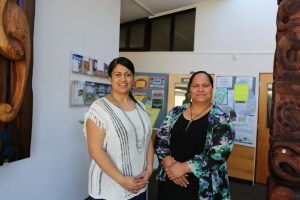
Te ao Maori through a Tairāwhiti lens: Te Whatukura lecturers Angela Tibble (left) and Maria Wynyard.
Hikoi can put wairua into study of Māori language and culture, and this year’s Ta Apirana Ngata Memorial Lectures are a pilgrimage of sorts as EIT lecturers help bring the past to life.
After so many who would have learnt and passed on cultural knowledge were lost in World War 2, Sir Apirana Ngata’s daughter and niece asked the great Māori leader to share his knowledge of language, culture, history and whakapapa with those who remained so it would not also be lost.
Dr Tamati Reedy re-started evening lectures in the ‘80s, then in the early 2000s they became more focused on contemporary issues. Last year the format changed again – to a three day wānanga based at three marae in the Ngati Porou and Te Whānau-a-Apanui region, with a Porou Ariki te reo wānanga immediately before.
Last year’s lectures traversed the East Coast in the footsteps of three prominent brothers of Ngāti Porou, and this year people have the opportunity to learn about three prominent wahine tapairu – Materoa, Te Ataakura and Tawhipare, who hail from Whareponga.
EIT Te Whatukura students who attend have described the experience as “life-changing”, says Te Whatukura co-ordinator Maria Wynyard who – along with fellow Te Whatukura lecturer Angela Tibble – support the annual lectures.
“It’s really exciting to go to those different marae – to traverse the land and get spoilt by the local treasures and the best spots they can show us in 24 hours. As teachers and tribal members, we always encourage participation in what’s happening locally, and nationally on some occasions. This enhances what they learn here as they see it and practise it.
Our team represents an average mix of different tribal members from our region, and we embed in our curriculum our protocols, tribal lore and histories.”
“You can get anything you want from a book or online – you can research it or read it but it never compares with being there. Our programmes give people the permission and the doorway to enter te ao Māori through a Tairāwhiti-enhanced lens”.
